Oil Price Uncertainty Shocks and Global Equity Markets: Evidence from a GVAR Model
Abstract
:1. Introduction
2. Data and Summary Statistics
3. Methodology
4. Empirical Results
4.1. Main Findings
4.2. Additional Results
4.2.1. The Role of Global Financial Crisis (GFC)
4.2.2. Robustness Checks with an Alternative Measure for Oil Price Uncertainty
5. Conclusions
Author Contributions
Funding
Data Availability Statement
Acknowledgments
Conflicts of Interest
| 1 | Basher and Sadorsky (2006) employ a multi-factor model to show that oil price risk tends to strongly affect a large set of emerging stock market returns. |
| 2 | The developed markets include Australia, Austria, Belgium, Canada, Finland, France, Germany, Italy, Japan, The Netherlands, Norway, New Zealand, Singapore, Spain, Sweden, Switzerland, United Kingdom and the USA; while the emerging markets are Argentina, Chile, India, Malaysia, Philippines, South Africa, South Korea and Thailand. Our choice of countries is guided by data availability, as we consider a more representative classification for all the countries following the Morgan Stanley Classification Index (MSCI). In other words, countries with fewer number of years as being developed but more years as emerging are classified as emerging, and same holds for our consideration for the developed countries. |
| 3 | https://www.econ.cam.ac.uk/people-files/emeritus/mhp1/GVAR/GVAR.html, accessed on 17 July 2022. |
| 4 | Data is available at https://www.econ.cam.ac.uk/people-files/emeritus/mhp1/GVAR/GVAR.html, accessed on 17 July 2022. However, data for the oil uncertainty index is not captured in the GVAR dataset and can be obtained from https://sites.google.com/site/nguyenhoaibao/oil-market-uncertainty?authuser=0, accessed on 17 July 2022. Note that, the monthly values of the oil price uncertainty index is converted to quarterly values by taking three-month averages over a quarter to match the quarterly frequency of the GVAR dataset. |
| 5 | The oil price uncertainty index is based on the conditional volatility of the unpredictable component of the real price of oil as measured by the Consumer Price Index (CPI)-deflated nominal values of the conventional US refiners’ acquisition cost for imported crude oil. The reader is referred to Nguyen et al. (2021) for further technical details. |
| 6 | See the link for the ranking and discussion of economic complexity https://www.visualcapitalist.com/countries-ranked-by-their-economic-complexity/, accessed on 17 July 2022. Highly ranked countries in terms of economic complexity imply a high diversity of exported products and sophisticated and unique exported products (i.e., few other countries produce similar products). |
| 7 | See the link for the ranking of countries by oil consumption per capita https://www.eia.gov/tools/faqs/faq.php?id=709&t=6, accessed on 17 July 2022. |
| 8 | The classification of countries into emerging and developed economies is drawn from the market classification by the Morgan Stanley Capital International (MSCI) (see https://www.msci.com/market-classification, accessed on 17 July 2022), while the World Fact Book of the Central Intelligence Agency (CIA) is used to group countries into net oil exporting and net oil importing countries. |
References
- Alsalman, Zeina. 2016. Oil price uncertainty and the US stock market analysis based on a GARCH-in-mean VAR model. Energy Economics 59: 251–60. [Google Scholar] [CrossRef]
- Aye, Goodness. 2015. Does oil price uncertainty matter for stock returns in South Africa? Investment Management and Financial Innovations 12: 179–88. [Google Scholar]
- Aye, Goodness, Mehmet Balcilar, and Rangan Gupta. 2017. International stock return predictability: Is the role of US time-varying? Empirica 44: 121–46. [Google Scholar] [CrossRef] [Green Version]
- Basher, Syed Abul, Alfred Haug, and Perry Sadorsky. 2012. Oil prices, exchange rates and emerging stock markets. Energy Economics 34: 227–40. [Google Scholar] [CrossRef] [Green Version]
- Basher, Syed Abul, and Perry Sadorsky. 2006. Oil price risk and emerging stock markets. Global Finance Journal 17: 224–51. [Google Scholar] [CrossRef]
- Bass, Alexander. 2017. Does oil prices uncertainty affect stock returns in Russia: A bivariate GARCH-in-mean approach. International Journal of Energy Economics and Policy 7: 224–30. [Google Scholar]
- Bayrakdaroglu, Ali, Çağatay Mirgen, and Ezgi Kuyu. 2017. Relationship between profitability ratios and stock prices: An empirical analysis on BIST-100. Press Academia Procedia 6: 1–10. [Google Scholar] [CrossRef]
- Benavides, Domingo Rodríguez, Miguel Ángel Martínez García, and Luis Fernando Hoyos Reyes. 2019. Uncertainty of the international oil price and stock returns in Mexico through an SVAR-MGARCH. Contaduría y administración 64: 1–16. [Google Scholar]
- Bernanke, Ben Shalom. 1983. Irreversibility, uncertainty, and cyclical investment. Quarterly Journal of Economics 98: 85–106. [Google Scholar] [CrossRef]
- Chen, Chun-Da, and Riza Demirer. 2022. Oil beta uncertainty and global stock returns. Energy Economics 112: 106150. [Google Scholar] [CrossRef]
- Chen, Shiu-Sheng. 2009. Do higher oil prices push the stock market into bear territory? Energy Economics 32: 490–95. [Google Scholar] [CrossRef]
- Chudik, Alexander, and Mohammad Hashem Pesaran. 2016. Theory and practice of GVAR modelling. Journal of Economic Surveys 30: 165–97. [Google Scholar] [CrossRef]
- Demirer, Riza, Aydin Yuksel, and Asli Yuksel. 2020a. Oil price uncertainty, global industry returns and active investment strategies. Journal of Economic Asymmetries 22: e00177. [Google Scholar] [CrossRef]
- Demirer, Riza, Rangan Gupta, Christian Pierdzioch, and Syed Jawad Hussain Shahzad. 2020b. The predictive power of oil price shocks on realized volatility of oil: A note. Resources Policy 69: 101856. [Google Scholar] [CrossRef] [PubMed]
- Demirer, Rıza, Shrikant Jategaonkar, and Ahmed Khalifa. 2015. Oil price risk exposure and the cross-section of stock returns: The case of net exporting countries. Energy Economics 49: 142–40. [Google Scholar] [CrossRef]
- Diaz, Elena Maria, Juan Carlos Molero, and Fernando Perez de Gracia. 2016. Oil price volatility and stock returns in the G7 economies. Energy Economics 54: 417–30. [Google Scholar] [CrossRef] [Green Version]
- Elder, John, and Apostolos Serletis. 2009. Oil price uncertainty in Canada. Energy Economics 31: 852–56. [Google Scholar] [CrossRef]
- Hatemi, J. Abdulnasser, Abdulrahman Al Shayeb, and Eduardo Roca. 2017. The effect of oil prices on stock prices: Fresh evidence from asymmetric causality tests. Applied Economics 49: 1584–92. [Google Scholar] [CrossRef]
- Henriques, Irene, and Perry Sadorsky. 2011. The effect of oil price volatility on strategic investment. Energy Economics 33: 79–87. [Google Scholar] [CrossRef]
- Jiranyakul, Komain. 2014. Does oil price uncertainty transmit to the Thai stock market? Journal of Economic & Financial Studies 2: 16–25. [Google Scholar]
- Jo, Soojin. 2014. The effects of oil price uncertainty on global real economic activity. Journal of Money, Credit and Banking 46: 1113–35. [Google Scholar] [CrossRef]
- Jordan, Steven, Andrew Vivian, and Mark Wohar. 2016. Forecasting market returns: Bagging or combining? International Journal of Forecasting 33: 102–20. [Google Scholar] [CrossRef] [Green Version]
- Jordan, Steven, Andrew Vivian, and Mark Wohar. 2017. Stock returns forecasting with metals: Sentiment vs. fundamentals. The European Journal of Finance 24: 458–77. [Google Scholar] [CrossRef] [Green Version]
- Liu, Ming-Lei, Qiang Ji, and Ying Fan. 2013. How does oil market uncertainty interact with other markets? An empirical analysis of implied volatility index. Energy 55: 860–68. [Google Scholar] [CrossRef]
- Maghyereh, Aktham, and Hussein Abdoh. 2020. Asymmetric effects of oil price uncertainty on corporate investment. Energy Economics 86: 1–19. [Google Scholar] [CrossRef]
- Masih, Rumi, Sanjay Peters, and Lurion De Mello. 2011. Oil price volatility and stock price fluctuations in an emerging market: Evidence from South Korea. Energy Economics 33: 975–86. [Google Scholar] [CrossRef]
- Mohaddes, Kamiar, and Mehdi Raissi. 2020. Compilation, Revision and Updating of the Global VAR (GVAR) Database, 1979Q2-2019Q4. Mimeo: University of Cambridge, Judge Business School. [Google Scholar] [CrossRef]
- Nguyen, Bao, Tatsuyoshi Okimoto, and Trung Duc Tran. 2021. Uncertainty-dependent and sign-dependent effects of oil market shocks. Journal of Commodity Markets 26: 100207. [Google Scholar] [CrossRef]
- Pesaran, Mohammad. Hashem, Til Schuermann, and Scott Weiner. 2004. Modeling Regional Interdependencies Using a Global Error-Correcting Macroeconometric Model. Journal of Business and Economic Statistics 22: 129–62. [Google Scholar] [CrossRef]
- Pindyck, Robert. 1991. Irreversibility, uncertainty, and investment. Journal of Economic Literature 29: 1110–48. [Google Scholar]
- Prodromou, Tina, and Riza Demirer. 2022. Oil Price Shocks and Cost of Capital: Does Market Liquidity Play a Role? Available online: https://ssrn.com/abstract=4144883 (accessed on 17 July 2022).
- Rahman, Sajjadur. 2021. Oil price volatility and the US stock market. Empirical Economics 61: 1461–89. [Google Scholar] [CrossRef]
- Sadorsky, Perry. 1999. Oil price shocks and stock market activity. Energy Economics 21: 449–69. [Google Scholar] [CrossRef]
- Salisu, Afees Adebare, Rangan Gupta, and Abeeb Olaniran. 2021. The effect of oil uncertainty shock on real GDP of 33 countries: A global VAR approach. Applied Economics Letters, 1–6. [Google Scholar] [CrossRef]
- Salisu, Afees Adebare, and Kazeem Isah. 2017. Revisiting the oil price and stock market nexus: A nonlinear Panel ARDL approach. Economic Modelling 66: 258–71. [Google Scholar] [CrossRef]
- Silvapulle, Param, Russell Smyth, Xibin Zhang, and Jean-Pierre Fenech. 2017. Nonparametric panel data model for crude oil and stock prices in net oil importing countries. Energy Economics 67: 255–67. [Google Scholar] [CrossRef]
- Sousa, Ricardo, Andrew Vivian, and Mark Wohar. 2016. Predicting asset returns in the BRICs: The role of macroeconomic and fundamental predictors. International Review of Economics and Finance 41: 122–43. [Google Scholar] [CrossRef] [Green Version]
- Stock, James, and Mark Watson. 2003. Forecasting Output and Inflation: The Role of Asset Prices. Journal of Economic Literature XLI: 788–829. [Google Scholar]
- Swaray, Raymond, and Afees Adebare Salisu. 2018. A firm-level analysis of the upstream-downstream dichotomy in the oil-stock nexus. Global Finance Journal 37: 199–218. [Google Scholar] [CrossRef]
- Van Eyden, Renee, Mamothoana Difeto, Rangan Gupta, and Mark Wohar. 2019. Oil price volatility and economic growth: Evidence from advanced economies using more than a century’s data. Applied Energy 233: 612–21. [Google Scholar] [CrossRef] [Green Version]
- Wang, Yudong, Chongfeng Wu, and Li Yang. 2013. Oil price shocks and stock market activities: Evidence from oil-importing and oil-exporting countries. Journal of Comparative Economics 41: 1220–39. [Google Scholar] [CrossRef]
- Yin, Libo, and Man Lu. 2022. Oil uncertainty and firms’ risk-taking. Energy Economics 108: 105922. [Google Scholar] [CrossRef]
- Zhu, Hui-Ming, Su-Fang Li, and Keming Yu. 2011. Crude oil shocks and stock markets: A panel threshold cointegration approach. Energy Economics 33: 987–94. [Google Scholar] [CrossRef]
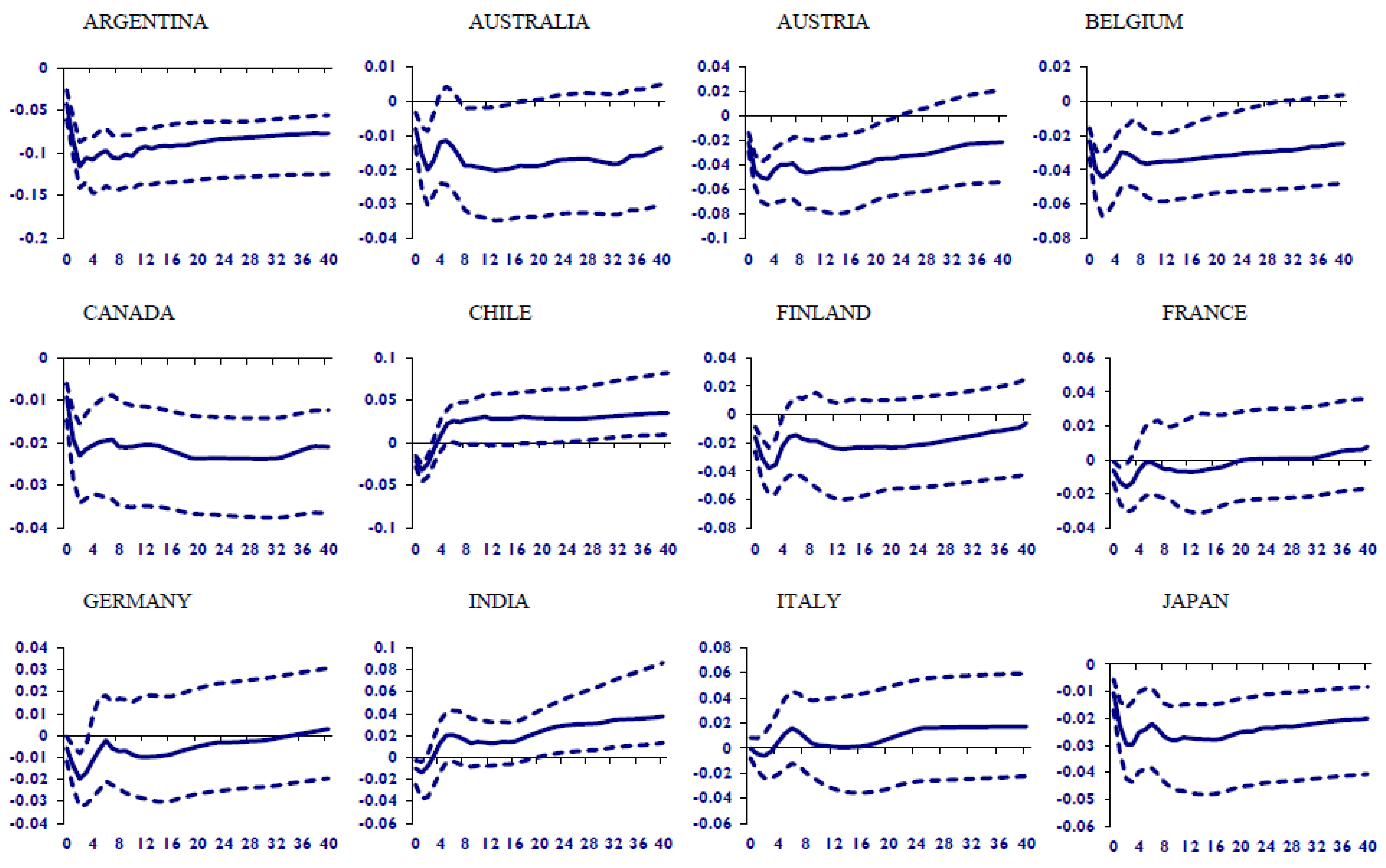


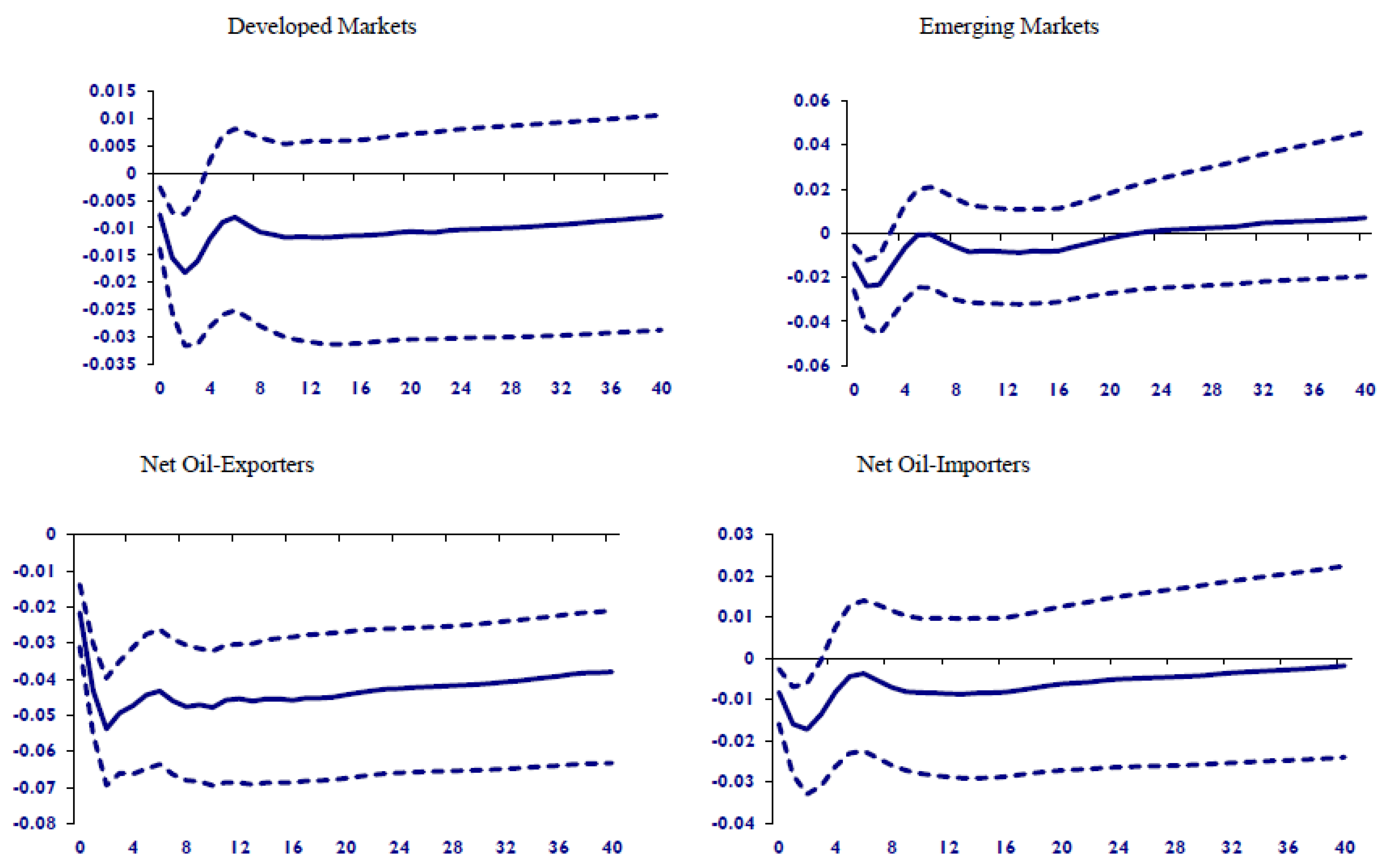

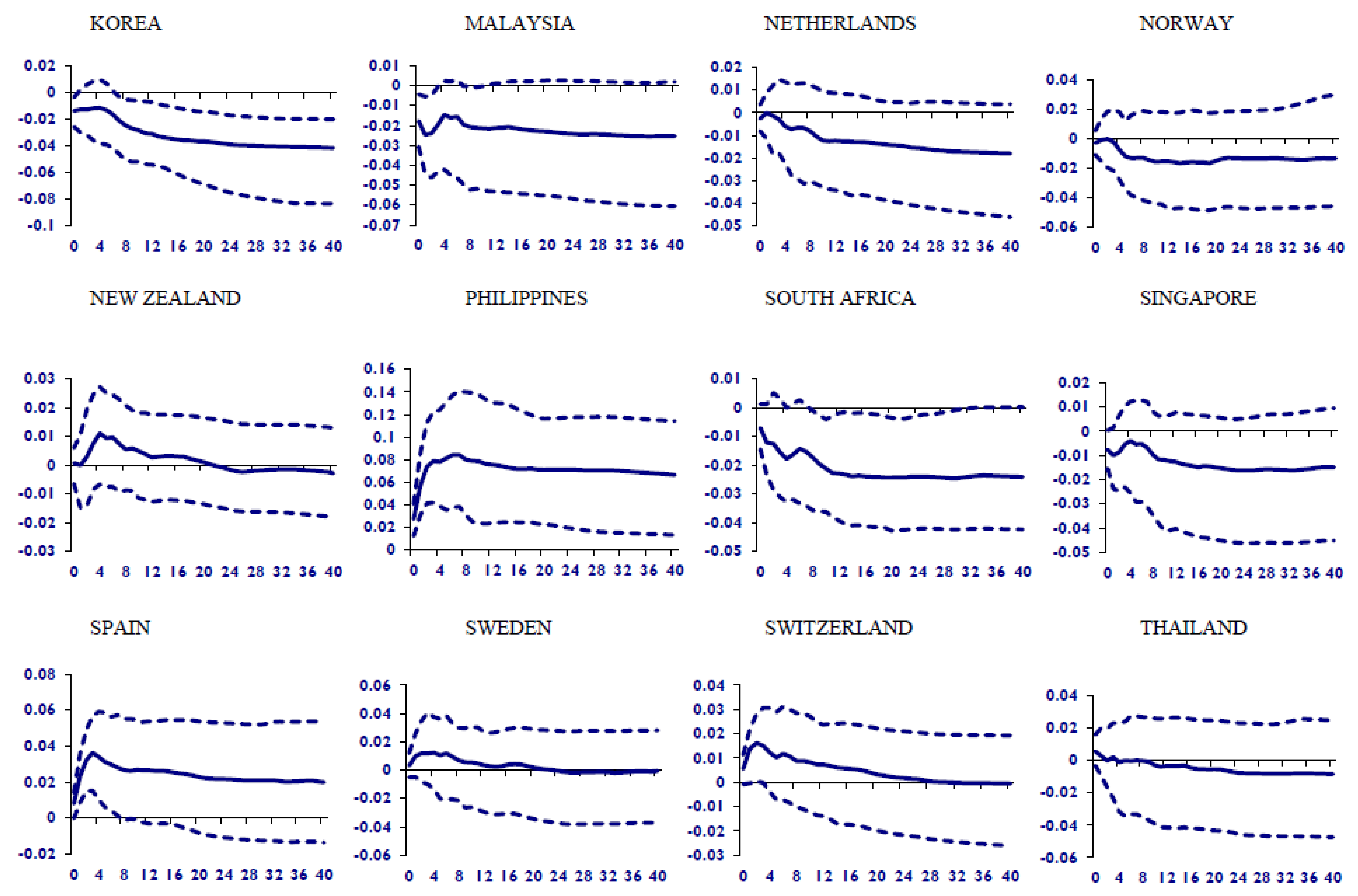

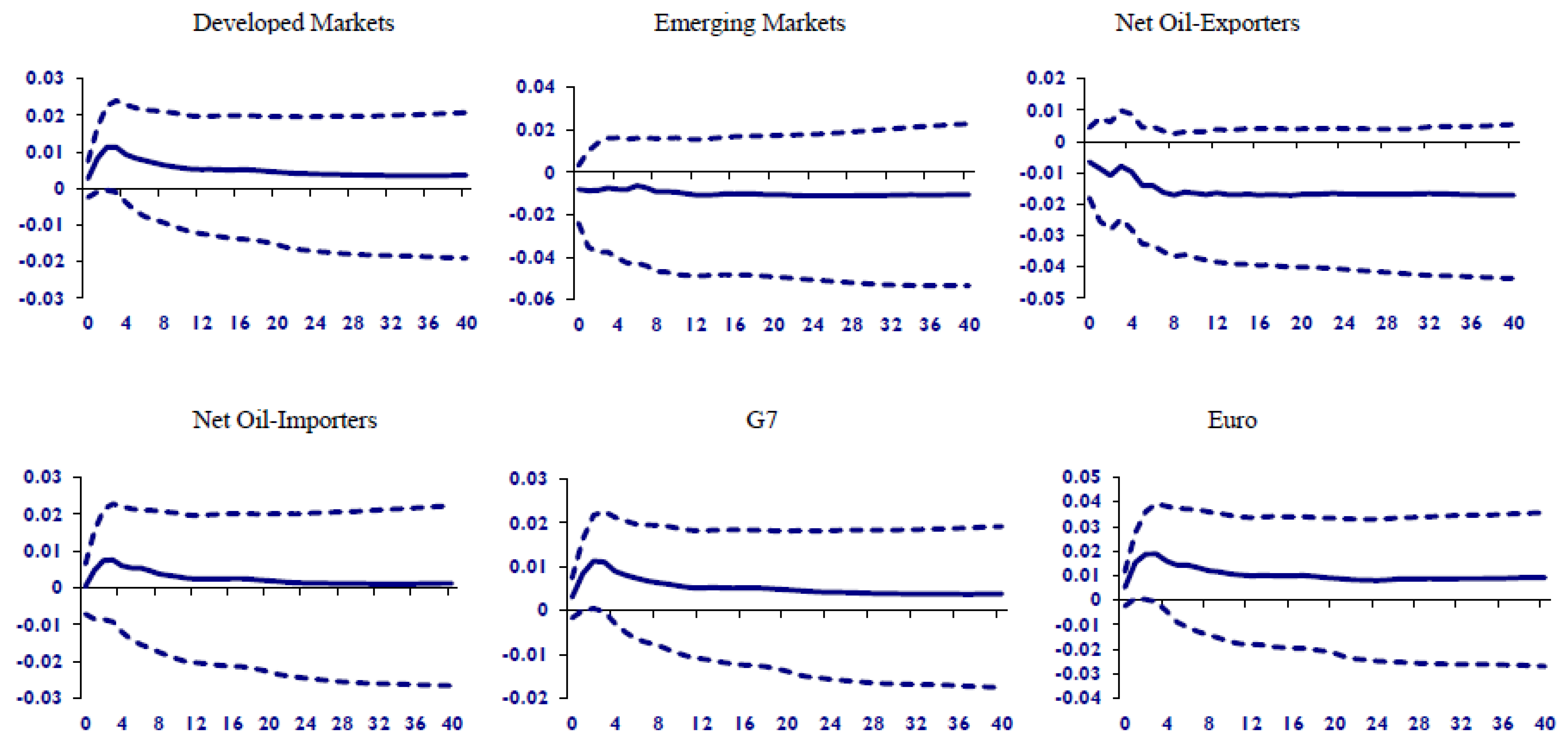
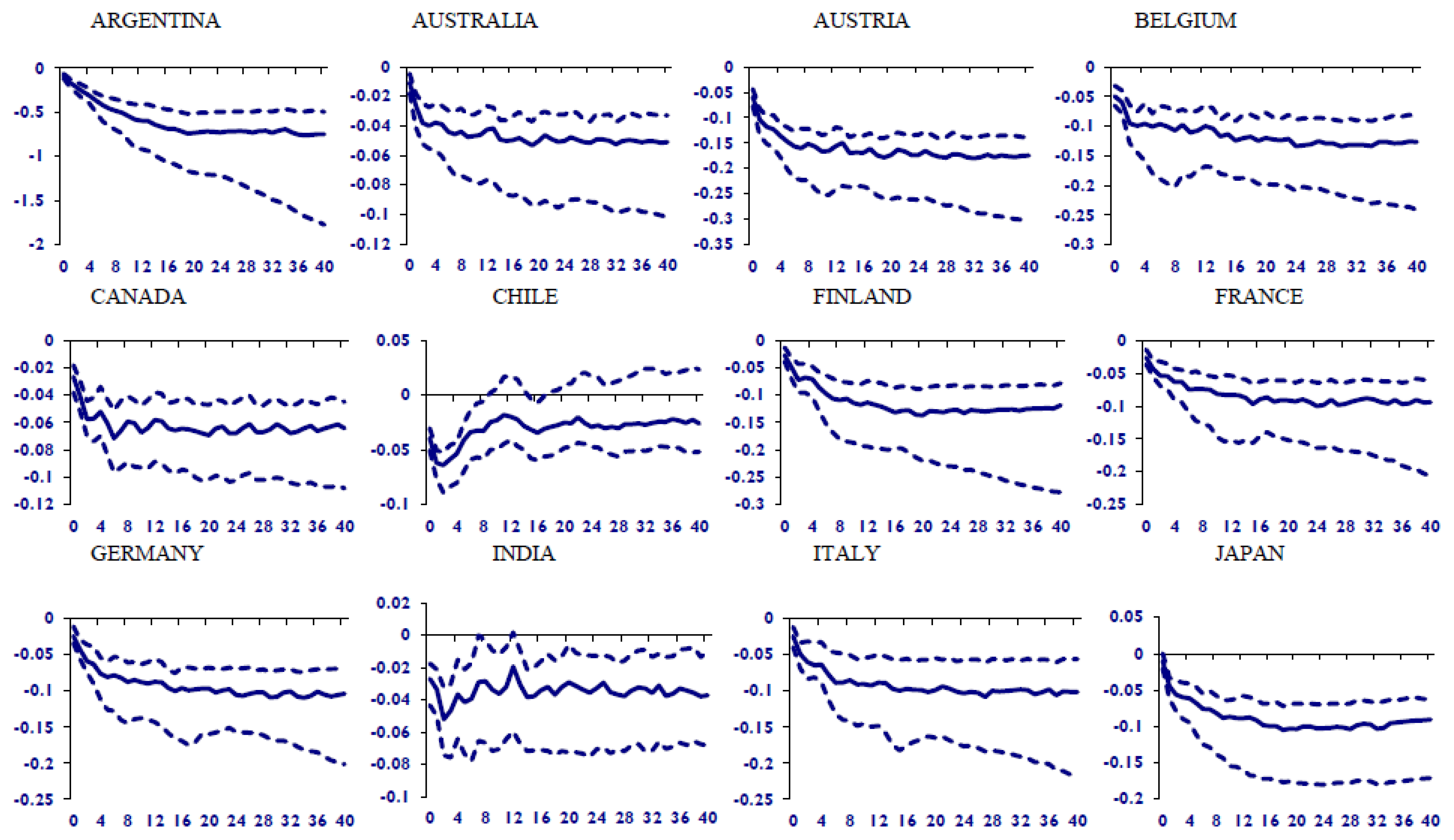
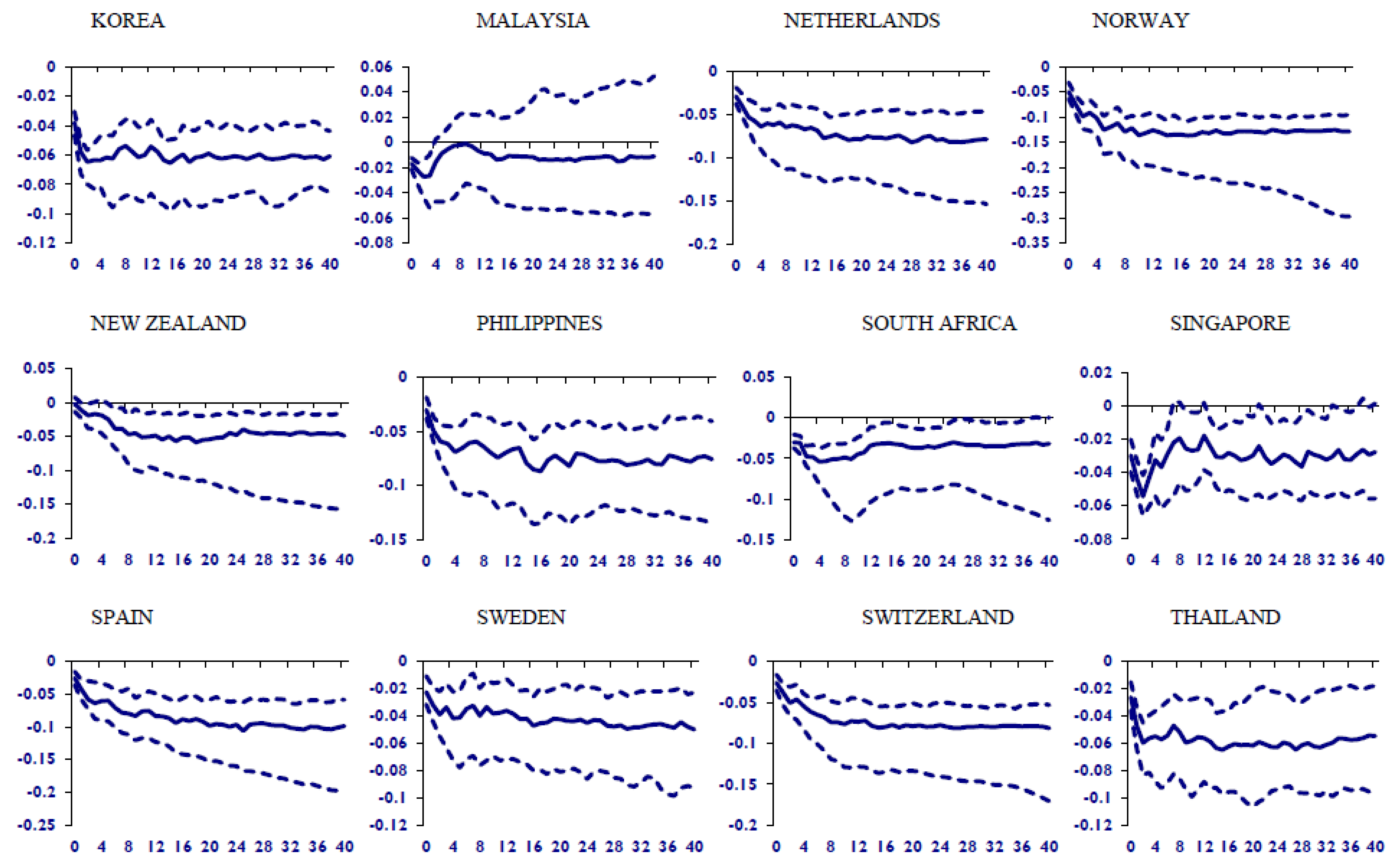

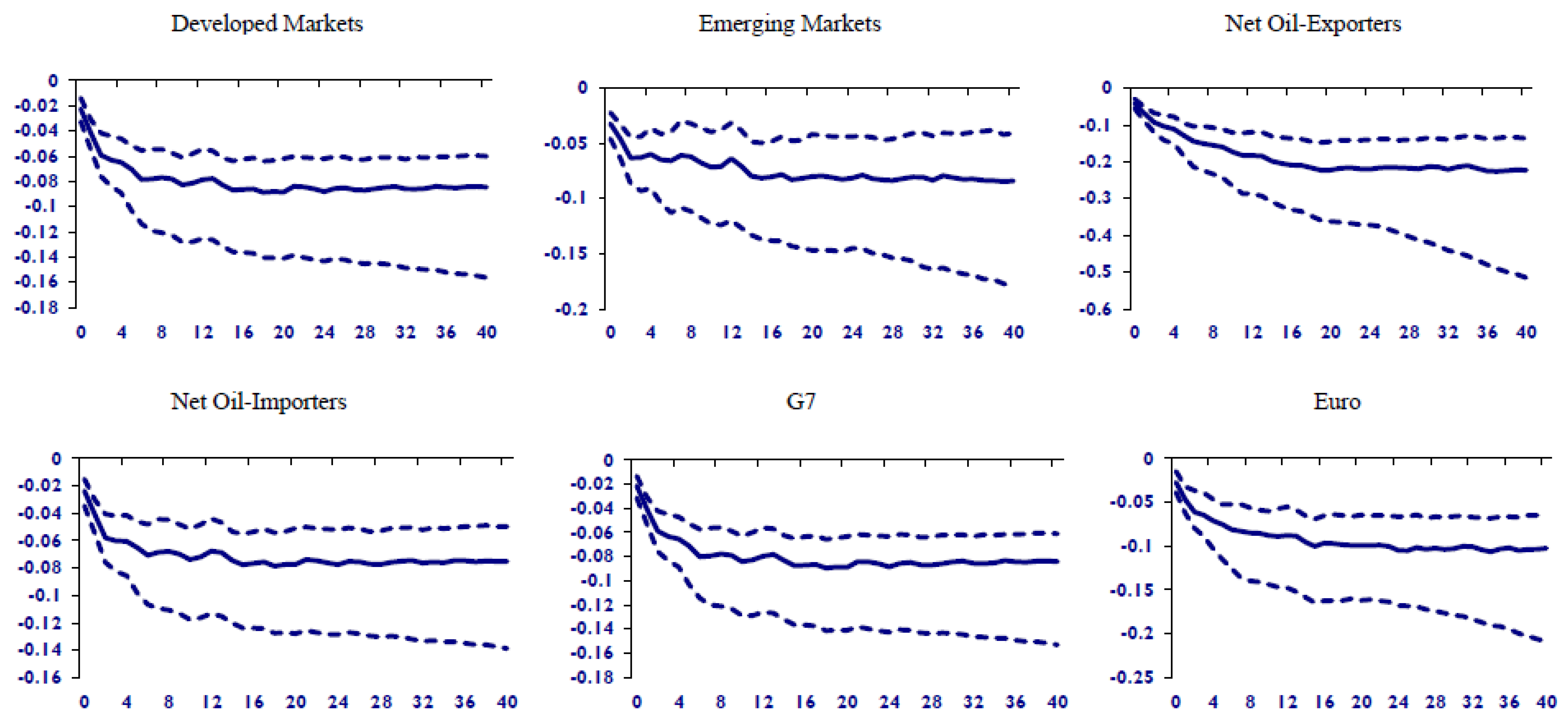



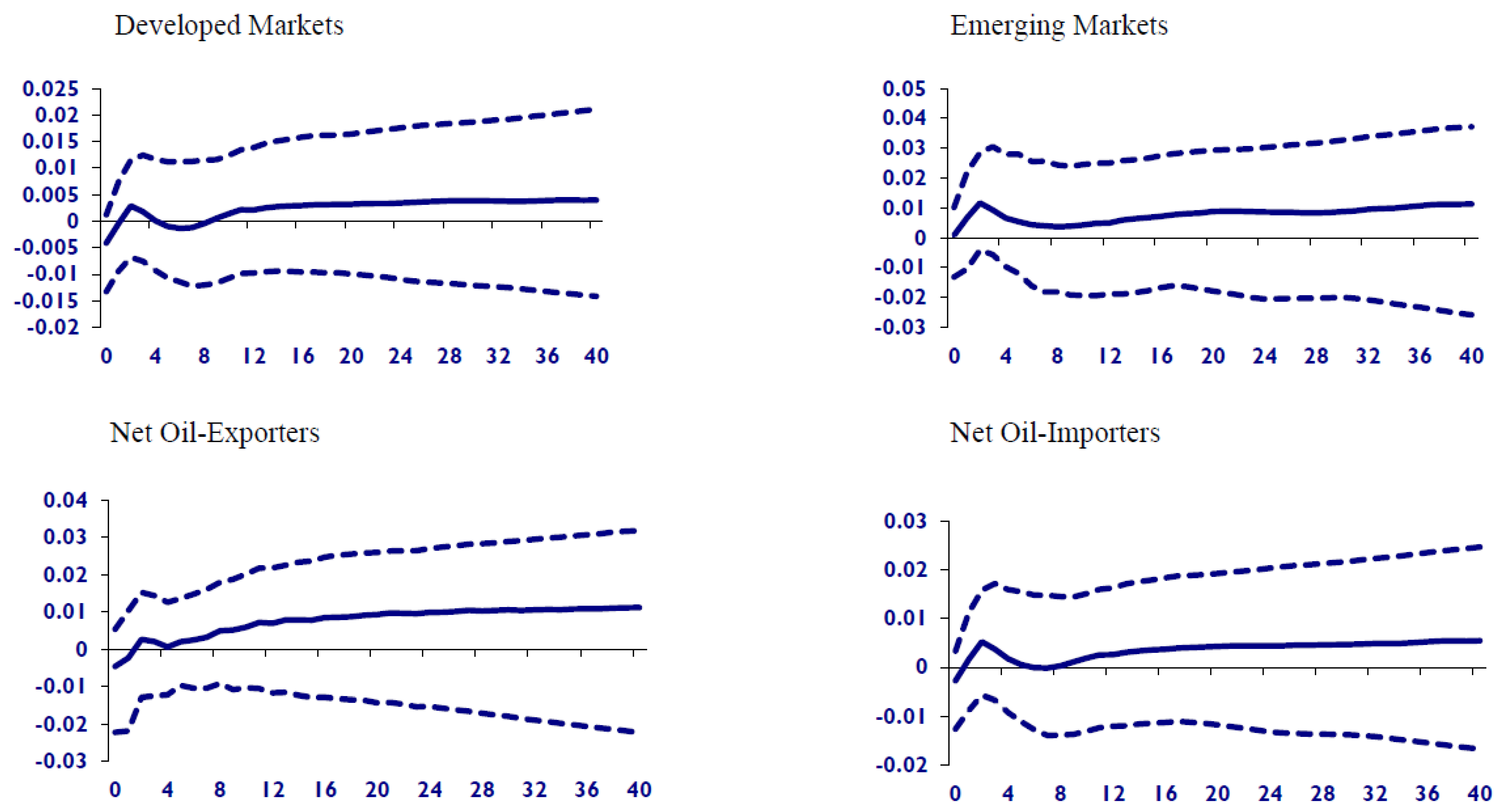
| Country | rgdp | Inf | reqp | rexr | s.int | l.int | ||||||||||||
|---|---|---|---|---|---|---|---|---|---|---|---|---|---|---|---|---|---|---|
| Mean | s.d | cv | Mean | s.d | cv | Mean | s.d | cv | Mean | s.d | cv | Mean | s.d | cv | Mean | s.d | cv | |
| Argentina | 4.64 | 0.35 | 0.08 | 0.14 | 0.25 | 1.79 | 0.23 | 0.61 | 2.65 | −4.05 | 0.43 | −0.11 | 0.12 | 0.19 | 1.58 | |||
| Australia | 4.55 | 0.38 | 0.08 | 0.01 | 0.01 | 1.00 | 2.09 | 0.47 | 0.22 | −4.29 | 0.40 | −0.09 | 0.02 | 0.01 | 0.50 | 0.02 | 0.01 | 0.50 |
| Austria | 4.53 | 0.25 | 0.06 | 0.01 | 0.00 | 0.00 | 1.42 | 0.65 | 0.46 | −4.72 | 0.37 | −0.08 | 0.01 | 0.01 | 1.00 | 0.01 | 0.01 | 1.00 |
| Belgium | 4.54 | 0.22 | 0.05 | 0.01 | 0.01 | 1.00 | 1.53 | 0.56 | 0.37 | −4.74 | 0.35 | −0.07 | 0.01 | 0.01 | 1.00 | 0.01 | 0.01 | 1.00 |
| Canada | 4.53 | 0.30 | 0.07 | 0.01 | 0.01 | 1.00 | 1.85 | 0.59 | 0.32 | −4.32 | 0.34 | −0.08 | 0.01 | 0.01 | 1.00 | 0.02 | 0.01 | 0.50 |
| Chile | 4.50 | 0.57 | 0.13 | 0.02 | 0.02 | 1.00 | 2.08 | 1.29 | 0.62 | 1.68 | 0.31 | 0.18 | 0.03 | 0.03 | 1.00 | |||
| Finland | 4.54 | 0.25 | 0.06 | 0.01 | 0.01 | 1.00 | 0.73 | 0.97 | 1.33 | −4.77 | 0.29 | −0.06 | 0.01 | 0.01 | 1.00 | |||
| France | 4.53 | 0.20 | 0.04 | 0.01 | 0.01 | 1.00 | 2.31 | 0.66 | 0.29 | −4.73 | 0.32 | −0.07 | 0.01 | 0.01 | 1.00 | 0.01 | 0.01 | 1.00 |
| Germany | 4.54 | 0.21 | 0.05 | 0.01 | 0.00 | 0.00 | 1.46 | 0.53 | 0.36 | −4.71 | 0.34 | −0.07 | 0.01 | 0.01 | 1.00 | 0.01 | 0.01 | 1.00 |
| India | 4.58 | 0.78 | 0.17 | 0.02 | 0.01 | 0.50 | 1.55 | 0.85 | 0.55 | −1.01 | 0.29 | −0.29 | 0.02 | 0.00 | 0.00 | |||
| Italy | 4.51 | 0.15 | 0.03 | 0.01 | 0.01 | 1.00 | 2.59 | 0.44 | 0.17 | −4.74 | 0.35 | −0.07 | 0.02 | 0.01 | 0.50 | 0.02 | 0.01 | 0.50 |
| Japan | 4.55 | 0.19 | 0.04 | 0.00 | 0.01 | 1.31 | 0.37 | 0.28 | 0.30 | 0.38 | 1.27 | 0.01 | 0.01 | 1.00 | 0.01 | 0.01 | 1.00 | |
| Korea | 4.42 | 0.64 | 0.14 | 0.01 | 0.01 | 1.00 | 0.63 | 0.60 | 0.95 | 2.39 | 0.31 | 0.13 | 0.02 | 0.01 | 0.50 | 0.02 | 0.01 | 0.50 |
| MALAYSIA | 4.46 | 0.66 | 0.15 | 0.01 | 0.01 | 1.00 | 1.57 | 0.44 | 0.28 | −3.41 | 0.18 | −0.05 | 0.01 | 0.00 | 0.00 | |||
| The Netherlands | 4.49 | 0.24 | 0.05 | 0.01 | 0.00 | 0.00 | 1.77 | 0.67 | 0.38 | −4.73 | 0.35 | −0.07 | 0.01 | 0.01 | 1.00 | 0.01 | 0.01 | 1.00 |
| NORWAY | 4.43 | 0.30 | 0.07 | 0.01 | 0.01 | 1.00 | 1.84 | 0.74 | 0.40 | −2.58 | 0.35 | −0.14 | 0.02 | 0.01 | 0.50 | 0.02 | 0.01 | 0.50 |
| NEW ZEALAND | 4.87 | 0.27 | 0.06 | 0.01 | 0.01 | 1.00 | 0.45 | 0.27 | 0.60 | −4.06 | 0.46 | −0.11 | 0.02 | 0.01 | 0.50 | 0.02 | 0.01 | 0.50 |
| PHILIPPINES | 4.68 | 0.46 | 0.10 | 0.02 | 0.02 | 1.00 | 1.48 | 1.13 | 0.76 | −0.92 | 0.34 | −0.37 | 0.02 | 0.02 | 1.00 | |||
| SOUTH AFRICA | 4.65 | 0.29 | 0.06 | 0.02 | 0.01 | 0.50 | 3.90 | 0.67 | 0.17 | −2.82 | 0.24 | −0.09 | 0.02 | 0.01 | 0.50 | 0.03 | 0.01 | 0.33 |
| SINGAPORE | 4.41 | 0.71 | 0.16 | 0.00 | 0.01 | 0.91 | 0.35 | 0.38 | −4.09 | 0.38 | −0.09 | 0.01 | 0.01 | 1.00 | ||||
| SPAIN | 4.52 | 0.28 | 0.06 | 0.01 | 0.01 | 1.00 | 0.67 | 0.68 | 1.01 | −4.76 | 0.39 | −0.08 | 0.02 | 0.01 | 0.50 | 0.02 | 0.01 | 0.50 |
| SWEDEN | 4.57 | 0.26 | 0.06 | 0.01 | 0.01 | 1.00 | 2.37 | 0.93 | 0.39 | −2.52 | 0.28 | −0.11 | 0.01 | 0.01 | 1.00 | 0.02 | 0.01 | 0.50 |
| SWITZERLAND | 4.59 | 0.20 | 0.04 | 0.00 | 0.01 | 1.45 | 0.77 | 0.53 | −4.22 | 0.43 | −0.10 | 0.01 | 0.01 | 1.00 | 0.01 | 0.00 | 0.00 | |
| THAILAND | 4.51 | 0.58 | 0.13 | 0.01 | 0.01 | 1.00 | 1.47 | 0.72 | 0.49 | −1.07 | 0.28 | −0.26 | 0.02 | 0.01 | 0.50 | |||
| UNITED KINGDOM | 4.54 | 0.25 | 0.06 | 0.01 | 0.01 | 1.00 | 3.16 | 0.44 | 0.14 | −4.98 | 0.36 | −0.07 | 0.01 | 0.01 | 1.00 | 0.02 | 0.01 | 0.50 |
| USA | 4.50 | 0.31 | 0.07 | 0.01 | 0.01 | 1.00 | 1.82 | 0.69 | 0.38 | #DIV/0! | 0.01 | 0.01 | 1.00 | 0.01 | 0.01 | 1.00 | ||
| Variables | Mean | med | s.d | cv |
|---|---|---|---|---|
| OIL PRICE | 0.69 | 0.65 | 1.18 | 1.710 |
| AGRICULTURAL COMMODITY PRICE | 4.58 | 4.61 | 5.10 | 1.114 |
| METAL PRICE | 4.46 | 4.29 | 5.52 | 1.238 |
Publisher’s Note: MDPI stays neutral with regard to jurisdictional claims in published maps and institutional affiliations. |
© 2022 by the authors. Licensee MDPI, Basel, Switzerland. This article is an open access article distributed under the terms and conditions of the Creative Commons Attribution (CC BY) license (https://creativecommons.org/licenses/by/4.0/).
Share and Cite
Salisu, A.A.; Gupta, R.; Demirer, R. Oil Price Uncertainty Shocks and Global Equity Markets: Evidence from a GVAR Model. J. Risk Financial Manag. 2022, 15, 355. https://doi.org/10.3390/jrfm15080355
Salisu AA, Gupta R, Demirer R. Oil Price Uncertainty Shocks and Global Equity Markets: Evidence from a GVAR Model. Journal of Risk and Financial Management. 2022; 15(8):355. https://doi.org/10.3390/jrfm15080355
Chicago/Turabian StyleSalisu, Afees A., Rangan Gupta, and Riza Demirer. 2022. "Oil Price Uncertainty Shocks and Global Equity Markets: Evidence from a GVAR Model" Journal of Risk and Financial Management 15, no. 8: 355. https://doi.org/10.3390/jrfm15080355
APA StyleSalisu, A. A., Gupta, R., & Demirer, R. (2022). Oil Price Uncertainty Shocks and Global Equity Markets: Evidence from a GVAR Model. Journal of Risk and Financial Management, 15(8), 355. https://doi.org/10.3390/jrfm15080355








